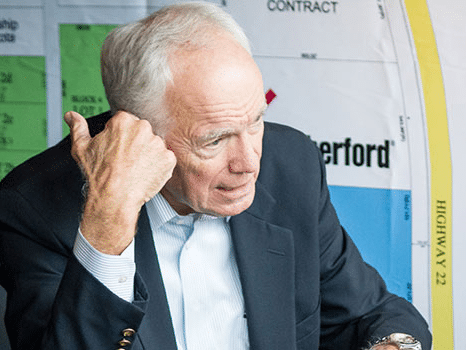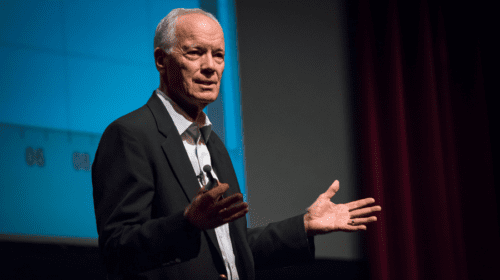Loren C. Scott is one of the 32-member National Business Economic Issues Council, which meets quarterly to discuss issues of state, national, and international interest. This group has experts who cover international trade, Washington economic policy, retail trade, trucking, steel, chemicals, etc.
Dr. Scott is an energy specialist on the NBEIC. He has been appointed to the Economic Advisory Board of the U.S. Council on Competitiveness – a group made up of the CEOs of the Fortune 100, top university presidents and presidents of three major unions. He has been interviewed on CNBC, MSNBC, and Bloomberg TV, in addition to several local TV stations, and his work has been cited in such publications as the Wall Street Journal, the Los Angeles Times, the New York Times, USA Today, and the Financial Times, to name a few.
His career started at Louisiana State University (LSU) in 1969 where he spent the next 33 years rising through the ranks from assistant professor to the prestigious Freeport McMoran Endowed Chair of Economics and the Director of the Division of Economic Development and Forecasting. Over the 13-year period from 1983-96, he was the chairman of the Economics Department at LSU. During that time, the Department’s ranking among the 3,000 economics departments in the U.S. rose from 101st to 38th. He is presently Professor Emeritus at LSU. He received seven awards at LSU for outstanding classroom teaching. He gives 50-70 speeches a year on the state of the economy.
Jason Spiess: How do you see the year 2016 for Merger and Acquisition activity?
Loren Scott: What you find happening when you go into a slump like the ones we are experiencing right now, is one of the ways companies deal with a downturn and these mergers and acquisitions. Number one it is a way to reduce overhead costs; you don’t need two accounting departments and you don’t need two finance departments. There’s a lot of overhead savings you can have. The second thing is that firms that do not have a lot of debt, and are looking at the longer term, may find some low hanging fruit to pick off here for people who don’t have the financial wherewithal to hang in there for the longer term. So it is possible to pick up some good stuff if you are financially able to hold on for a while.
JS: How about when it comes to the non-oil companies, services companies or distribution companies. The low gas prices could trigger some investments or expansions that could become risks if gas prices shot up next year. Much like the energy companies who made significant investments to accommodate $100 oil, then the price drop, now they are in trouble. Do you see any companies or how companies could be setting themselves up or do you see them using the low gas prices to right their ship?
LS: More of the latter. Number one, anyone who is involved in the energy sector, anything involving oil and gas at all, just knows this is like riding a roller coaster at an amusement park, it is just like that all the time. It is not a nice straight upward going line.
One of the things that is characteristic of this industry is a high degree of volatility. That’s one of the things you have to learn to live with in this industry. When we first went into this back in the late ’70s and early ’80s we saw oil go from $3-a-barrel to like $35-a-barrel, and one of the things that was happening was the lenders and the capital market was just shoveling money into this area. Anybody and everybody could get money – doctors, lawyers and Indian chiefs.
Then when we had the big crash between 1982 and 1986, everybody got smarter and everybody said wait a minute, this can happen again. And suddenly you find that only the really well-run firms had survived. Number two you found out the capital market no longer shoveled money out like they did in the late ’70s and early ’80s.
Everybody got smarter and everybody started running their ship a lot tighter. And the lenders got much tighter with lending money.
So when we go through a downturn like we are going through right now, it is tough, it is hard, and you are seeing a lot of layoffs, but let me tell you something, you are not seeing anything like the layoffs we experienced from 1982 through 1986. That period, for example, Louisiana went from having a 103,000 people working in oil and gas extraction to around 45,000. We were like an unopened parachute.
Now what happened was, when oil prices started to recover, even when we got into the $100-barrel-of-oil, employment in oil and gas still stayed around 48 – 49,000. It never went way back up again because people were smarter. We can experience something exactly like we are experiencing right now. What you have is most of the firms in the industry are pretty tightly run. Some of them will get into a little bit of trouble and they just can’t hold on for the long haul, and you will see the mergers and acquisitions there, but I just don’t think we are going to experience anything like we saw between 1982 and 1986.
JS: How about on the technology side of things. Seeing the benefits of their research and development dollars, streamlining their costs with technology. Are you seeing any new advancements in technology that are showing significant costs savings for these energy firms?
LS: That’s the neat thing about watching this industry, and I’ve been watching it for four decades now, is the people in this industry are remarkably clever and remarkably quick on responding to the market. For example, just what they are doing in the deep waters of the Gulf of Mexico, their ability to drill two miles deep then five miles deep in the bottom of the ocean. Technology that is more difficult than landing a person on the moon. When it comes to the fracking side, when you have prices decline like they have now, you find all kinds of efforts made to do things more efficiently. One of the things they do is the exploration companies go to the service companies and say, ‘Look, we were getting $100-a-barrel, not we are getting $35. Guess what, you are going to have to give us a break on your prices.’
There’s been a shoving down of the price pressure down to the service firms and then the service firms shove it down to the people who supply them. That’s part of what is going on, the other is they are just getting clever. For example, back in 2007, a typical well in the Bakken play would produce 100-barrels-a-day in its first year. Now it is producing 500. They are figuring out how to get more and more oil out of the shale once they frac it. Drilling time has dropped sometimes as many as 21 days down to seven-and-a-half. They are just really quick people in this industry, and when they are under pressure with lower oil prices, they figure out a way to get more oil out of the ground and get more oil out a lot cheaper. That’s why the breakeven point keeps falling in all of these shale plays. They are just clever, clever people.
JS: How about some of this energy infrastructure. Two things that stand out in my mind. One is our last conversation and you mentioned the enormous amount of potential investments in the Gulf Coast area and the other is a conversation I had with Federal Energy Regulatory Commissioner Tony Clark. Commissioner Clark explained how Germany is paying $15 to $18 for natural gas due to their inferior infrastructure. What are you hearing in your neck of the woods with the major infrastructure investments?
LS: Well number one, the oil and gas sector is in a funk, so areas like Lafayette, Ahoma, New Orleans to some extent, Shreveport, with any oil and gas extraction dependency are really suffering and losing jobs right now. Again nothing like in the 1982 to 1986 time period for losing jobs.
At the other extreme, are the areas around Baton Rouge and Lake Charles, where you have two things going on. You have this tremendous boom with the expansion of the chemical industry. And then you have, especially in the Lake Charles area, about seven LNG export facilities, that have been announced. Two of them are underway and five of them are waiting in the wings. We have had, a typical good year in the past, five billion dollars in industrial announcements around the state, and we would have thought that was great.
We have a $145 billion. It’s an enormous expansion, and the primary driver behind all this is the fact that natural gas is a huge element in producing chemicals. Even some fertilizers are made out of natural gas. Then of course natural gas is a clean burning fuel, and this goes into a lot different things. Our natural gas prices are much below Germany and Asia. The problem with Germany, I would argue, isn’t so much the infrastructure as they don’t produce their own natural gas, because they have outlawed fracking, those dummies.
They have to get their natural gas from Russia, and Russia prices their natural gas off their price of oil. When the price of oil is $100 a barrel, they take about 15% of that and charge $15 per million BTUs for their natural gas. Chemical companies can not possibly compete with us if we are paying only $3 per million BTUs. So we have really been kicking their rears in international chemical market. We’ve just been eating into their market share. Some of these announcements have not gone vertical yet, and they are moving over a bit and tapping their foot on the brake, because again, Russia and Qatar and other exporters of natural gas price their natural gas off the price of oil.
Again when the price of oil was $100 a barrel, they were charging $15. Well now it is $30 a barrel, and they are charging a much lower price, so our competitive advantage has started to narrow a good bit, as a matter a fact, quite a good bit, because of this decline in the price of oil.
And so some of these companies have not gone vertical yet, they are waiting until they see what happens, meaning until they see where the price of oil settles down.
JS: Several years ago there was a rush for deep Arctic and other oceanic mineral rights by Russia, China and the U.S.; maybe other countries too. Are you hearing anything in the deep sea drilling area of oil and gas?
LS: What you are seeing happening right now, because of the low price of natural gas, some of these more difficult environments like the Arctic and Antarctica and other places like that; Shell, for example, has pulled out of the deep waters in Alaska where they had planned to go in.
The low oil prices have impacted the deep water activity. One thing is you find firms not as interested as going into those harsher environments. The second thing that is happening is a lot of firms are saying, publically, instead of drilling in the deep waters of the Gulf of Mexico, they’re starting to look more at going into the shale plays.
They are playing this little balancing game. Here’s the deal. One reason they would shift from the deep waters to say the Bakken shale play, it costs about $8 million dollars to drill a well in the Bakken. It costs $130 million to drill in the Gulf of Mexico. You are almost 100% sure you are going to hit in the Bakken. You are not so 100% sure you are going to hit in the Gulf of Mexico. Sometimes you might spend a $130 million and not hit anything. That’s the positive for the onshore drilling and the shift to onshore drilling. The negative is that when you drill and you hit in the Bakken play, you get most of your oil in the first year. You may get a little bit more in the that second year, but after that you have a very steep decline curve in the shale plays.
In the Gulf of Mexico you don’t; you have a very slow dropping decline curve. More importantly, as I mentioned before, when you drill a well in the Bakken, on the average you get 500-barrels-a-day the first year. You drill a well in the Gulf of Mexico, it is 9,000-barrels-a-day. So you have to gauge this calculus of do we go for the sure thing, the cheap thing in shale plays, or go for the expensive high reward if you hit in the Gulf of Mexico. Some of them quite frankly are saying, let’s go for the sure thing in the Bakken plays and Permian Basin and places like that. So if anything right now, the deep waters are certainly the harsher waters of the world, and you are starting to see some backing off and companies going toward shale instead of the other direction.
JS: There is a substantial amount of doom and gloom in the media with oil and gas. The Bakken is still pumping out over a million barrels a day, which tells me at $30, it is an industry. The oil and gas shale plays almost appear like a commodity play much like corn or soy. That is a very simplistic summary for one of the most complex industries in the marketplace. Your thoughts on the state of the oil and gas economy?
LS: Well there’s no question oil and gas is very important in states like North Dakota. I mentioned the sharp decline curve; you are going to see a decline in production in the Bakken play because you are not drilling nearly as many wells as you did in the past. I think the peak in the Bakken was around 192, and today they are around 60, and when you have that deep of a decline in drilling and given the steep decline curve, the combination of those two things means your output is going to start to fall.
But 60 rigs is still a significant industry in the Bakken area. There is still a lot oil to be pumped there, and the people who work in this industry know that the price does swing the other way. We’ve gone down one side of the ‘V’ and there’s always another side of the ‘V’ in the future, it’s just a question of when is that other side going to come and how far up is it going to go. And this is the second most difficult thing in the economy to forecast, oil prices, and that’s why you just have to learn to live with the uncertainty of it.

Jason Spiess is a multimedia journalist, entrepreneur and content consultant. Spiess has over 25 years of media experience in broadcasting, journalism, reporting and principal ownership in media companies. (Over 30 years experience if you count his adolescent years as a newspaper delivery boy learning the importance and logistics of daily distribution and monthly door-to-door bill collecting.) Spiess has worked in the areas of oil and gas, UAS and precision agriculture, health care, cannabis, agriculture, real estate, government affairs and economic development. Spiess is the host of two radio programs, Building the Bakken and Coffee & Capitalism, and three specialty programs, MonDak OilField Review, Corporate Ink and UnStuck, that carry a radio network that spans five states and two countries. Spiess is a North Dakota native and graduated from North Dakota State University.












